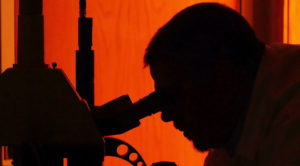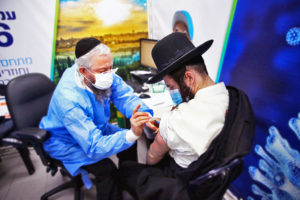On a dull morning, 25 years ago, scores of journalists and TV crews gathered at The Royal Free hospital in north London. The occasion was a press conference for a five-page, 4,000-word “paper” in The Lancet medical journal. Thousands of such reports pump out each week from hundreds of publications around the world. The best are in English, the language of science, to be trawled by health and medical reporters hunting easy clicks and page views: “A statin a day keeps the doc away.” “Study blames dementia on obesity.”
True breakthroughs are rare (the cause of Aids; Dolly the Sheep) and almost none is granted the kind of establishment send-off as the research unveiled that morning. For months, private briefings had teased the press regarding what was coming. The hospital installed answering machines to field the alarm it expected. And both its medical school’s dean and a top professor stepped forward with a mid-rank lab researcher to introduce a “study” that wouldn’t only stalk the nightmares of a generation of young parents, but shovel trenches for a war that has raged ever since.
“The study has identified a possible link between gut disorders in children and autism,” a press release explained, with 21 minutes of video clips to maximise TV pick-up. “In the majority of cases, the onset of symptoms occurred soon after the MMR vaccination.”
Ahh, MMR: the measles, mumps, and rubella shot. What Brit beyond their teens never noticed the fallout that rained from that morning’s event? Over months and years, vaccination rates slumped, and measles returned to kill or maim children as the most agonising health scare since the early years of Aids unleashed outbreaks of fear, guilt, and disease. That night, TV news tracked the Royal Free script:
“Questions were raised today about the safety of the combined mumps, measles, and rubella vaccine…”
“Claims there could be a link between a common childhood vaccine and autism…”
This was February 26, 1998, with the paper datelined to the following Saturday. Beneath a technobabble title, 13 authors were listed. But only one wrote it: Andrew Wakefield. Then aged 41, a bowel surgeon by training, he had a large-chested voice, a patrician manner, and what admirers described as “charisma”. Dressed in a black suit at a blue-clothed table, with the dean stood to his left and the professor sat to his right, he pitched a story to draft a page in medical history. He had gathered data from a series of 12 developmentally challenged kids, anonymised in the paper by number. They had been admitted to the Royal Free for an unprecedented five-day battery of tests he had devised, including needles into their spines, tubes deep into their guts, brain scans, x-rays, and blood work.
His first “finding” would echo down the decades like machine-gun fire in a cathedral. For eight of the 12 (aged from three to nine), the paper said their parents, quizzed by doctors running the tests, recounted a terrifyingly similar experience: a son or daughter was developing normally, received a shot of the three-in-one “live virus” MMR, and showed autistic symptoms within days.
The paper further claimed discovery of a new medical “syndrome” of both brain and bowel disease in the children. All but one, it reported in text and tables, had developmental issues plus “chronic enterocolitis” — inflammation of both the large and small intestine. “It’s a moral issue for me,” Wakefield told his audience, calling for MMR to be suspended in favour of single shots for measles, mumps, and rubella. “I can’t support the continued use of these three vaccines, given in combination, until this issue has been resolved.” The dean equivocated, but the professor backed Wakefield. And so was born an intractable controversy as the paper was leveraged to launch a crusade: first against this vaccine, then later another… and another… all the way to SARS-CoV-2.
“It’s not a vaccine at all,” Wakefield would rail against the latter at the height of the Covid pandemic. “It’s actually genetic engineering.” Back in 1998, his ground had been firmer, even based on a mere dozen patients. Many medical insights begin with short case series. Autism: 11 kids in the Baltimore area, for example. Aids: five men in Los Angeles. That Thursday, it seemed possible the Royal Free had got lucky: maybe catching the first snapshot of a hidden epidemic of catastrophic injuries to kids. Massive studies around the world, however, found nothing to confirm this, leaving a whale of a riddle rotting on the beach. If parents of two-thirds of 12 children with developmental issues blamed the triple shot for the sudden onset of autism, why weren’t vaccine victims everywhere? Wakefield doubled down, claiming they were. But, while the medical establishment sought refuge in authority, urging the public to trust experts, not a lone-voice maverick, an old-school Sunday Times investigation, run by me, would pepper revelations across more than the next decade, revealing what this doctor had done.
Our first report splashed in February 2004, almost exactly six years after the press conference. “Revealed: MMR research scandal,” was the front page, igniting a new media firestorm. We had discovered a monstrous conflict of interest that Wakefield kept hidden, then denied. For two years before his “moral issue” surfaced — and before any of the children set foot in the hospital — he had been payrolled by a small-town solicitor named Richard Barr to help lead an attack on MMR. Unlike expert witnesses, who give advice and opinions, the doctor was delegated to arrange the tests, building pressure for a speculative lawsuit.
“I have mentioned to you before,” Barr wrote to Wakefield, six months before the Royal Free event, “the prime objective is to produce unassailable evidence in court so as to convince a court that these vaccines are dangerous.” Barr filed the lawsuit at the Royal Courts of Justice eight months after the breathless press conference. Wakefield claimed fees of £150 an hour (about £254 an hour at late 2022 values), drawn from the government’s legal aid fund. So, as he recruited the children and wrote the paper, he had a financial incentive not only to trigger a client-grabbing furore, but to keep it going for as long as he could.
Those clients poured in — nearly 1,600 families — as journalists were duped to fuel the scare. And by late 2003, when Barr’s lawsuit collapsed, Wakefield had. been handed £435,643 (about £738,000, or nearly US $900,000, at last year’s values), plus expenses, in taxpayers’ money. But as he gazed into the glare of TV lights, his legal deal was only one of his secrets. As he’d made his call for a switch to single vaccines, he forgot to mention that eight months previously he’d filed a confidential claim at the London Patent Office for his own, supposedly safer, single vaccine.
His shot wouldn’t have worked. When I asked experts about it, they laughed. But four days after the Royal Free event, he put it to the medical school that they start a joint company to raise money for this, and other products he’d imagined, which only stood much chance of enticing investors if confidence in MMR was damaged. Yet this doctor wasn’t shy of shady stuff, even hopelessly suing me for what a High Court judge described as “public-relations purposes”. So I carried on digging for years, on-and-off, exposing secrets and lies by the bucket. “If my son really is Patient 11, then the Lancet article is simply an outright fabrication,” complained the father of a California boy brought to London for the tests, after I found the dad and showed him a copy. “I know that paper is not right and fraudulent,” the mother of another boy, from the north of England, emailed me. “I can see that from what was written about my son.”
Confidential medical records (lawfully checked) confirmed the parents’ right to be angry. Some of the kids said to have symptoms days after MMR, actually had them before or up to nine months later. Some were reported with “autism” without this diagnosis. Tests for bowel disease came back normal. None of Wakefield’s data revealed enterocolitis: the chief gastrointestinal symptom was constipation. Parents blaming the shot, moreover, wasn’t even a “finding” — it was a covert qualification to take part. Records showed that not eight, but 11 of the kids’ families named the vaccine at the hospital (the 12th’s later joined them to file a claim in the lawsuit) — a give-away number, sure to provoke questions, if Wakefield hadn’t airbrushed the figures. The poisonous truth was that all but the American family had links with vaccine activists caught up in Barr’s plans, pointing them to Wakefield’s project. And, surprise, legal aid authorities at the time insisted that, for cases to qualify for public funding, alleged symptoms must follow within days.
Wakefield was finished, but he couldn’t say sorry. And when The Sunday Times ran with “MMR doctor fixed data on autism”, he fought back, denying all error. “The notion that any researcher can cook such data in any fashion that can be slipped past the medical community for his personal benefit is patent nonsense,” he argued, in one of countless lengthy rejoinders. He wasn’t alone in not wishing us well. Much of the medical establishment was aggrieved. “I will now defend the heretic Dr Andrew Wakefield,” sneered, for instance, Bad Science author Dr Ben Goldacre. “The media are fingering the wrong man, and they know who should really take the blame: in MMR, journalists and editors have constructed their greatest hoax.”
But tunes changed abruptly in May 2010, after a hearing longer than the trial of OJ Simpson in which the General Medical Council vindicated what we’d published and scrubbed Wakefield from the doctors’ register. The Lancet, which for 12 years defended the paper, retracted it. And, after opposing the GMC proceedings, the British Medical Journal highlighted the irony. “It has taken the diligent scepticism of one man,” the BMJ said in an editorial, “standing outside medicine and science, to show that the paper was in fact an elaborate fraud”.
I won’t forget that, and not just for my name-check but because the establishment mobilised to vilify journalists rather than hold a mirror to themselves. How could it be that all the doctors and professors, royal colleges and government experts, steeped in more medicine than I’d know how to spell, failed to spot that the paper was a scam? It was as if they couldn’t accept the ugly truth was even possible. A chap wouldn’t do such a thing. So, in plain view of a dozen co-authors, platformed by a hospital and its medical school, and published after peer review in a most prestigious journal, he’d effortlessly exploited conceits and vulnerabilities that remain below the radar to this day.
Personally, I’d trust The Daily Mail before The Lancet (especially the football and TV data). But, if Wakefield had ploughed a field of less instant public interest — say, psychogeriatrics or kidney surgery — his chances of getting caught were close to zero. He might have published fake findings until the day he retired, and no newspaper reporter could have convinced their editors to pay for what it would take to prove what happened. So, the next time you read of some medical marvel, remember the lesson of the Wakefield scandal. As I put it in The Doctor Who Fooled the World, (published after he’d moved on to trashing Covid vaccines): “If he could do what he did — and I’ll show you what he did — who else is doing what in the hospitals and laboratories that we may one day look to for our lives?”
Disclaimer
Some of the posts we share are controversial and we do not necessarily agree with them in the whole extend. Sometimes we agree with the content or part of it but we do not agree with the narration or language. Nevertheless we find them somehow interesting, valuable and/or informative or we share them, because we strongly believe in freedom of speech, free press and journalism. We strongly encourage you to have a critical approach to all the content, do your own research and analysis to build your own opinion.
We would be glad to have your feedback.
Source: UnHerd Read the original article here: https://unherd.com/





